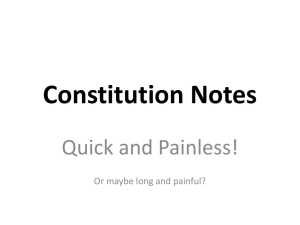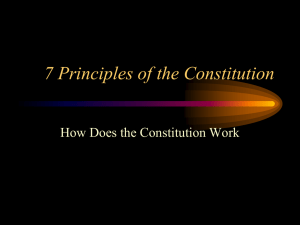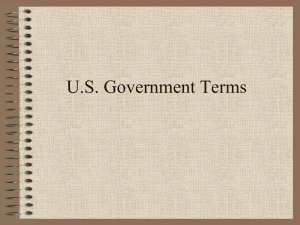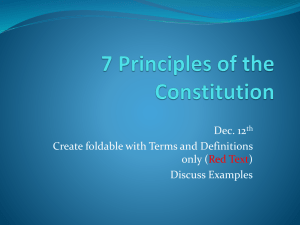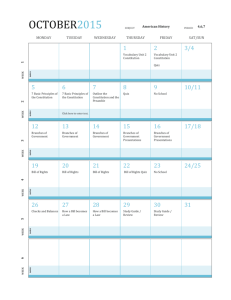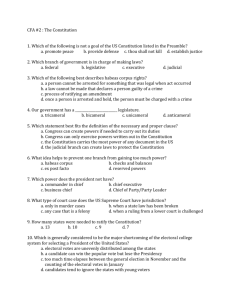Separation of Powers - National Constitution Center
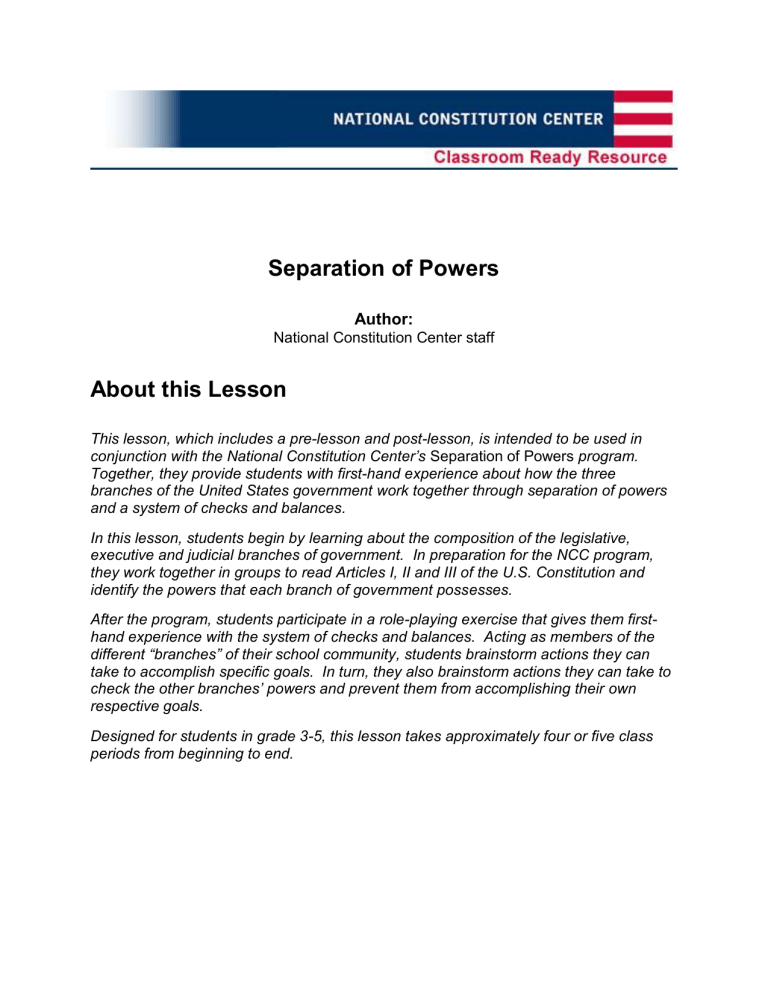
Separation of Powers
Author:
National Constitution Center staff
About this Lesson
This lesson, which includes a pre-lesson and post-lesson, is intended to be used in conjunction with the National Constitution Center’s
Separation of Powers program.
Together, they provide students with first-hand experience about how the three branches of the United States government work together through separation of powers and a system of checks and balances.
In this lesson, students begin by learning about the composition of the legislative, executive and judicial branches of government. In preparation for the NCC program, they work together in groups to read Articles I, II and III of the U.S. Constitution and identify the powers that each branch of government possesses.
After the program, students participate in a role-playing exercise that gives them firsthand experience with the system of checks and balances. Acting as members of the different
“branches” of their school community, students brainstorm actions they can take to accomplish specific goals. In turn, they also brainstorm actions they can take to check the other branches’ powers and prevent them from accomplishing their own respective goals.
Designed for students in grade 3-5, this lesson takes approximately four or five class periods from beginning to end.
[Title]
Nation al Con stitution Ce nter
Classr oom Re ad y Resour ce
Background
Grade(s) Level
3-5
Classroom Time
Two 45-minute class periods (prelesson)
When the Founding Fathers wrote and ratified the
Constitution, they wanted to make sure that the government did not abuse its power. To this end, the
Founders separated powers among three branches of government: the legislative (law-making), the executive
(law-enforcing), and the judicial (law-interpreting) branches.
Two or three 45-minute periods
(post-lesson)
Handouts
United States Constitution with
Amendments
( http://www.constitutioncenter.org/n cc_edu_Text_of_the_Constitution.a
spx )
Who’s Got the Power? student worksheet
Among the many powers given to the legislative branch, or the Congress, are the powers to introduce bills, collect taxes, regulate commerce with foreign countries, coin money, and declare war. The head of the executive branch, or the president, serves as the commander-inchief of the U.S. Army and Navy, has the power to make treaties, propose and veto legislation, and nominate ambassadors and justices of the Supreme Court. The president also appoints public officials, such as members of the Cabinet and heads of federal agencies, all of whom round out the executive branch. Lastly, the judicial branch, which includes the Supreme Court and lower federal courts, has the power to interpret U.S. law by issuing judgments in cases.
You Be The Principal!; You Be The
Teacher Congress!; and You Be
The Student Supreme Court!
student worksheets
Constitution Connections
Articles
In addition to separating powers among the three branches of government, the Founders created a system of checks and balances that enables each branch to limit the powers of the other two branches.
I, II, III The system of checks and balances is perhaps best illustrated through the process by which a bill becomes a law. While the legislative branch is the only branch that has the power to introduce legislation, the executive branch has the power to enforce laws. All bills that are passed by both the Senate and the House of
Representatives must be presented to the president. As the head of the executive branch, the president can sign a bill into law, veto a bill, or do nothing, in which case the bill becomes law after ten days. In this sense, the executive branch checks the power of the legislative branch. In turn, if a bill is vetoed, the Congress has the power to check the president’s power by reconsidering the bill. If two-thirds of both the Senate and the House of
Representatives approve the bill, it becomes law. Finally, the judicial branch checks the law-making powers of the executive and legislative branches because it has the power to judge a law to be unconstitutional.
P a g e | 2
[Title]
Nation al Con stitution Ce nter
Classr oom Re ad y Resour ce
Objectives
Students will:
Identify the composition of the three branches of government;
Understand how powers are separated among the three branches;
Learn about each branch’s powers through interpreting Articles
I, II and III of the Constitution; and
Gain first-hand experience with the system of checks and balances through participating in a role-playing exercise about their school community.
Standards
5.1.3.B: Explain rules and laws for the classroom, school, and community.
5.1.3.D: Identify key ideas about government found in significant documents:
Declaration of Independence
United States Constitution
Bill of Rights
Pennsylvania Constitution
5.3.3.A: Identify the roles of the three branches of government.
Activity
Pre-Lesson
1. Introduce students to the concept of separation of powers by asking them how their school community is divided into different groups of people, each of which plays a different role in making the school community function smoothly. While the structures of schools vary considerably, consider providing the following examples to get students started:
Teachers make up one group and are responsible for planning lessons, grading papers, enforcing school rules, keeping students safe, making learning fun, etc.
The principal and assistant principals form a second group and are in charge of creating school rules, planning school-wide events, communicating with the school district, evaluating test scores, etc.
P a g e | 3
[Title]
Nation al Con stitution Ce nter
Classr oom Re ad y Resour ce
Members of the custodial staff and non-teaching assistants form a third group and are in charge of keeping the school building clean, maintaining safety and order in the hallways and on the playground, preparing the school for important events, etc.
Students form a fourth group and are responsible for learning, treating each other kindly, having fun, respecting school rules, representing their school positively in the larger community, etc.
2. Explain that, just as a school community is made up of different groups, the U.S. government is made up of three groups, or branches, each of which has its own set of powers and jobs. Ask students the following questions to guide the discussion.
What are the names of the three branches of government?
Who makes up the legislative branch?
Who makes up the executive branch?
Who makes up the judicial branch?
3. As students deliberate answers to the questions above, make sure that they learn the following information about the three branches of government.
The U.S. government is comprised of three branches: the executive, legislative and judicial branches.
The legislative branch, or the Congress, is a bicameral legislature, meaning that it has two distinct parts: the Senate and the House of
Representatives. The Senate has 100 members, with two from each state. The House of Representatives has 435 members, with at least two from each state. Each state’s number of representatives varies directly with its population; more populated states, like New York and California, therefore have more representatives. Voters elect their senators every six years and their representatives every two years.
The executive branch includes the president, members of the Cabinet, and heads of additional federal agencies. Voters elect a president every four years. In turn, the president appoints individuals as ambassadors, members of the Cabinet, and heads of several additional federal agencies, including the C.I.A. and Environmental Protection Agency. Members of the Cabinet oversee 15 executive departments, including the Departments of Homeland Security, Education, Health and Human Services, etc.
The judicial branch consists of the U.S. Supreme Court and lower federal courts. Nine justices, including a chief justice, comprise the Supreme
Court and are appointed by the president and confirmed by the Senate.
Justices remain in office until they choose to resign, pass away or are impeached or convicted by Congress. Federal judges who serve in the country’s many district courts or one of the country’s 13 courts of appeals are also appointed, not elected, and serve indefinitely.
P a g e | 4
[Title]
Nation al Con stitution Ce nter
Classr oom Re ad y Resour ce
4. Explain that the U.S. Constitution grants specific powers to each branch of government. More commonly known as “separation of powers,” the distinct powers of each branch make it harder for the government to abuse its power.
Divide students into mixed ability groups of 4-5 and distribute copies of Articles I,
II, and III of the Constitution and of the student worksheet Who’s Got the Power?
Ask students to complete the worksheet by reading the text of the Articles to determine which branch of government possesses each of the 15 powers on the worksheet.
Because some of the language in the Articles is complicated, students will likely need your help with making sense of it. You can also narrow down their searching by telling them which sections of each Article contain information about a branch’s powers.
Powers of the Legislative Branch: Article I, Sections 7 & 8
Powers of the Executive Branch: Article II, Sections 2 & 3
Powers of the Judicial Branch: Article III, Section 2
Once all groups have completed the worksheet, review the correct answers (see
Answer Key ) and remind students that the Founding Fathers separated important powers among the three branches of government in order to prevent any of the branches from becoming too powerful and therefore harming the rights and wellbeing of citizens.
Explain to students that each branch of government also has the ability to check the powers of the other two branches, meaning that each branch can limit or stop the actions of the oth er two branches. The National Constitution Center’s
Separation of Powers program will help students learn more about how the three branches check each other’s powers.
Post-Lesson
1. After students have participated in the Separation of Powers program, they will be ready to put what they have learned about the system of checks and balances to the test in a role-playing exercise about their school community. Divide students into three mixed-ability groups. The groups will represent the different branches of the school community, each of which is modeled closely after the branches of the U.S. government.
2. Distribute one of three student worksheets to each group ( You Be The Principal!;
You Be The Teacher Congress!; or You Be The Student Supreme Court!
). Each worksheet asks students to imagine that their school community has been designed to function like the U.S. government with three different branches, separation of powers, and a system of checks and balances. The worksheet
P a g e | 5
[Title]
Nation al Con stitution Ce nter
Classr oom Re ad y Resour ce includes a summary of the branch
’s powers, a list of how it can check other branches ’ powers, and a specific role-playing scenario with directions.
3. Provide each group with 10-15 minutes to read the worksheet and prepare the role-playing scenario. Students will need to familiarize themselves with their branch ’s powers and goal and then brainstorm actions that they can take to accomplish this goal. Ask students in each group to write down at least three specific actions they would take.
4. After students have prepared their scenarios, bring the three groups together for the role-playing exercise. Begin by having members of the executive branch present their scenario, including their goal and the actions they plan to take in order to accomplish this goal. Repeat this step for the legislative and judicial branches.
5. Provide the groups with 15-20 minutes to brainstorm how they would prevent the other two branches from accomplishing their goals through checking their powers. Ask students in each group to write down at least two specific actions they would take.
6. Bring the three groups together again. Begin by having members of the executive branch present the ways in which they would attempt to prevent the legislative and judicial branches from accomplishing their goals. Repeat this step for the legislative and judicial groups.
7. Conclude the exercise by leading a brief discussion about how the separation of powers and system of checks and balances makes it difficult for a single branch of government to abuse its power.
Further Resources
http://ratify.constitutioncenter.org/constitution/
(NCC’s Interactive
Constitution)
http://www.whitehouse.gov/our-government (The White House’s resource about separation of powers and checks and balances)
P a g e | 6
[Title]
Nation al Con stitution Ce nter
Classr oom Re ad y Resour ce
Who’s Got The Power?
Directions: Working together as a group, complete the chart below by identifying which branch of government possesses each of the powers. Use Articles I (Sections 7
& 8), II (Sections 2 & 3) and III (Section 2) of the Constitution to help you.
Power
Introduces laws
Declares laws unconstitutional
Signs bills into law
Coins money
Nominates Supreme Court justices
Declares war
Vetoes bills
Interprets/Makes meaning of laws
Serves as commander-in-chief of the army and navy
Issues a pardon
Overrides a presidential veto
Borrows money on behalf of the
United States
Makes treaties
Impeaches/Removes the president
Branch of Government
(legislative, executive or judicial?)
P a g e | 7
[Title]
Nation al Con stitution Ce nter
Classr oom Re ad y Resour ce
Who’s Got The Power?
Answer Key
Power
Introduces laws
Declares laws unconstitutional
Signs bills into law
Coins money
Nominates Supreme Court justices
Declares war
Vetoes bills
Interprets/Makes meaning of laws
Serves as commander-in-chief of the army and navy
Issues a pardon
Overrides a presidential veto
Borrows money on behalf of the
United States
Makes treaties
Impeaches/Removes the president
Branch of Government
(legislative, executive or judicial?)
legislative judicial executive legislative executive legislative executive judicial executive executive legislative legislative executive legislative
P a g e | 8
[Title]
Nation al Con stitution Ce nter
Classr oom Re ad y Resour ce
You Be The School Principal!
Imagine that your school community is divided into three branches, just like the
U.S. government. Each branch has its own powers (or jobs) and its own ways of checking the powers of the other two branches.
As the school principal, or the head of the school’s executive branch, you have the power to:
Propose new school laws to the Teacher Congress (the legislative branch);
Sign bills into school law;
Veto bills from becoming school laws;
Make agreements or pacts with other schools;
Make executive appointments (choose student justices for the Student Supreme
Court; hire a new assistant principal; etc.); and
Grant pardons (forgiveness) to students and teachers.
You can check the powers of the Teacher Congress by:
Proposing new school laws; and
Vetoing bills from becoming school law.
You can check the powers of the Student Supreme Court by:
Appointing student justices who share your opinions; and
Enf orcing the Court’s decisions in the school community.
Directions for Part One: Read the role-playing scenario below and familiarize yourself with your branch’s goal. Then, brainstorm a list of actions/steps that your branch has the power to take in order to accomplish your goal. An example is provided for you.
Scenario/Goal:
After another busy morning at school, you realize that it’s already 10 a.m., and you still haven’t had a chance to eat breakfast. But you have another meeting starting in five m inutes, and that doesn’t leave you enough time to run down to the cafeteria and wait in line for a bagel and juice. You’ll have to wait until lunchtime to eat.
Not satisfied, you decide that a student should bring breakfast to your office each morning at 8:15. You do the math and realize that if each student in grades 3-5 brings you breakfast just twice during the school year, you will be able to eat breakfast every morning. After all, it’s the least your older students can do to thank you for being their principal for all these years.
Excited about your new idea, you discuss it with the assistant principal, who tells you that it’s not fair to expect students to bring you breakfast. But you’re not going to let
P a g e | 9
[Title]
Nation al Con stitution Ce nter
Classr oom Re ad y Resour ce this stop you. You brainstorm a list of actions you have the power to take in order to accomplish your goal.
Actions to Accomplish Your Goal:
You share your idea with another principal at your monthly principals’ meeting.
Together, you sign a principals’ pact, pledging that he will support your breakfast
idea if, in return, you support his effort to build a new playground at his school.
Directions for Part Two: Think about the goals that the other two branches of the school community have presented to you. Given the ways in which you can check their powers, brainstorm a list of actions/steps you would take to check each branch’s power and make it difficult for each branch to accomplish its goal.
Actions to Check the Teacher Congress’ Goal:
Actions to Check the Student Supreme Cour t’s Goal:
P a g e | 10
[Title]
Nation al Con stitution Ce nter
Classr oom Re ad y Resour ce
You Be The Teacher Congress!
Imagine that your school community is divided into three branches, just like the
U.S. government. Each branch has its own powers (or jobs) and its own ways of checking the powers of the other two branches.
As a member of the Teacher Congress, or the school’s legislative branch, you have the power to:
Introduce new school laws;
Override a principal’s veto;
Raise money on behalf of the school;
Distribute money to the executive branch (the principal); and
Impeach or remove the principal.
You can check the powers of the principal by:
Overriding a principal’s veto on a bill;
Impeaching or removing the principal; and
Approving the principal’s appointments to the Student Supreme Court and other positions, like the assistant principal.
You can check the powers of the Student Supreme Court by:
Confirming appointments of student justices to the Court;
Impeaching or removing student justices; and
Proposing new amendments to the School Constitution.
Directions for Part One: Read the role-playing scenario below and familiarize yourself with your branch’s goal. Then, brainstorm a list of actions/steps that your branch has the power to take in order to accomplish your goal. An example is provided for you.
Scenario/Goal:
After many faculty room discussions, you and some of your fellow members of the Teacher Congress have decided that all students in grades 3-5 should have two hours of homework each weekend. After all, the weekend is long, and there’s no reason why doing two hours of homework should prevent your students from also having fun, spending time with their families, playing on their sports teams, doing their chores, sleeping, etc.
At the next meeting of the Teacher Congress, you brainstorm actions you can take to begin requiring weekend homework as soon as possible.
P a g e | 11
[Title]
Nation al Con stitution Ce nter
Classr oom Re ad y Resour ce
Actions to Accomplish Your Goal:
You introduce a bill (new school law) that requires all students in grades 3-5 to complete two hours of homework each weekend: 30 minutes of math, 30 minutes of writing, 15 minutes of spelling, 15 minutes of vocabulary, and 30 minutes of
independent reading.
Directions for Part Two: Think about the goals that the other two branches of the school community have presented to you. Given the ways in which you can check their powers, brainstorm a list of actions/steps you would take to check each branch’s power and make it difficult for each branch to accomplish its goal.
Actions to Check the Principal ’s Goal:
Actions to Check the Student Sup reme Court’s Goal:
P a g e | 12
[Title]
Nation al Con stitution Ce nter
Classr oom Re ad y Resour ce
You Be The Student Supreme Court!
Imagine that your school community is divided into three branches, just like the
U.S. government. Each branch has its own powers (or jobs) and its own ways of checking the powers of the other two branches.
As a member of the Student Supreme Court, or the highest court in the school’s judicial branch, you have the power to:
Declare school laws unconstitutional; and
Interpret/Make meaning of laws.
You can check the powers of the principal by:
Declaring the principal’s actions unconstitutional.
You can check the powers of the Teacher Congress by:
Declaring school laws unconstitutional.
Directions for Part One: Read the role-playing scenario below and familiarize yourself with you r branch’s goal. Then, brainstorm a list of actions/steps that your branch has the power to take in order to accomplish your goal. An example is provided for you.
Scenario/Goal:
You and your fellow student justices have decided that students in grades 3-5 need more recess time each day. Because gym class is only 45 minutes once a week and lunchtime recess is only 20 minutes each afternoon, you think that older students need more time to exercise and burn off their energy. Adding one 30-minute morning recess each day would help students be healthier and make it easier for them to concentrate on their schoolwork.
Actions to Accomplish Your Goal:
You rule in favor of Bart Simpson in Springfield Elementary v. Simpson (2011), a school court case in which a fourth grader refuses to do his homework because
he doesn’t think he has enough time to play at school.
P a g e | 13
[Title]
Nation al Con stitution Ce nter
Classr oom Re ad y Resour ce
Directions for Part Two: Think about the goals that the other two branches of the school community have presented to you. Given the ways in which you can check their powers, brainstorm a list of actions/steps you would take to check each branch’s power and make it difficult for each branch to accomplish its goal.
Actions to Check the Principal ’s Goal:
Actions to Check the Teacher Congress
’ Goal:
P a g e | 14


